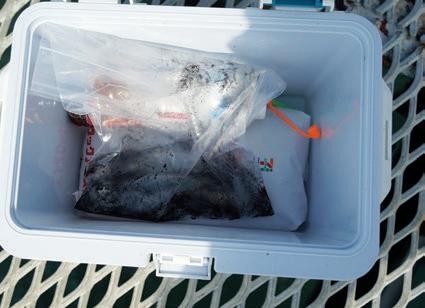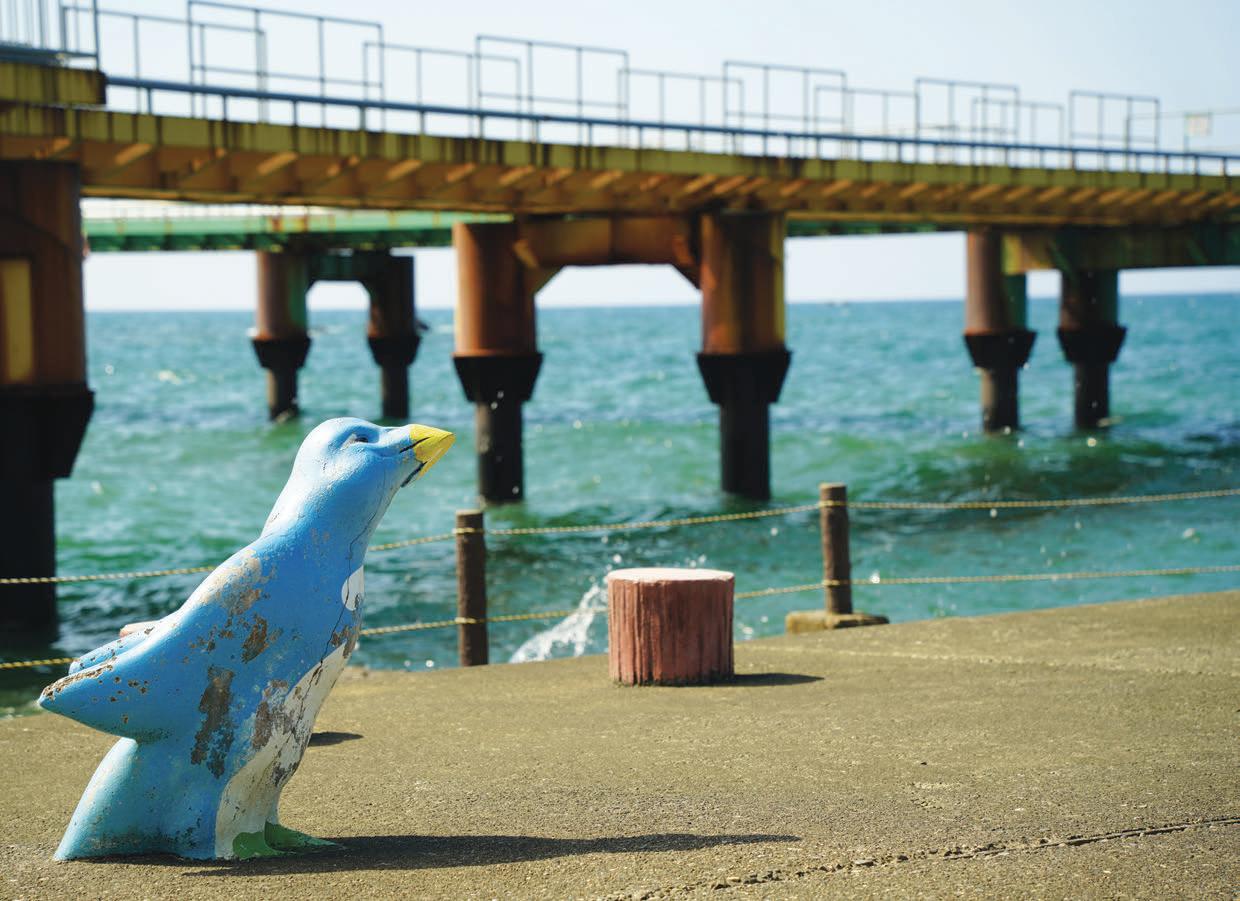
8 minute read
CALAMARI DREAMS IN JAPAN
SQUIRT SQUAD SAGAS
FROM CALIFORNIA TO JAPAN, AN ANGLER LOVES JIGGING UP SQUID FOR CALAMARI
By Lance Sawa
Afull moon during a fall Friday in my Southern California youth always meant one thing for me: squid.
My dad would pick me up from school – the car already loaded with everything we needed: rods, tackle and snacks for the night – and we’d head to the marina. Together we would get on a boat rigged up with lights pointing toward the water.
After getting underway I would start preparing the rods with the squid jigs. Back then you had to tie each one separately with a bit of line between the jigs, then the sinker at the bottom. How many on each rod was up to the angler, though most had about five. Being young, I could only handle about three. (These days you can buy prerigged squid jigs with just the hooks and line. They are wonderful, fast and about the same price.)
The anchor went down after the captain found squid. Even though it was night, once the boat’s massive lights came on everything around us was illuminated. Despite the lights being pointed down, enough light still spilled out to make it painful to look in their direction. In the cold night, though, the heat from them was enough to keep us from being too cold.


Nico Sawa shows off his first squid, caught while fishing with his dad, author Lance Sawa, in Japan. It’s a tradition that started when Lance was a youngster in California. (LANCE SAWA)
The rickety pier in Joetsu, in Niigata Prefecture on the other side of the island of Honshu from Tokyo, not only attracted anglers but beach lovers and playground warriors, including Nico. (LANCE SAWA)


Slowly creatures began to gather near each light. First were the small shrimps and other zooplankton. Then the small fish that eat the plankton moved into the light. And then came larger fish like mackerel and barracuda, which eat the small fish. Finally, we’d have one squid, then another, then hopefully a blanket of squid would appear under each light. At this point people had scoop nets out and pulled up squid easily. Earlier, I had been jigging and getting one and two at a time, taking a few minutes each time to get them up. It wasn’t long before squid were being dropped into the tank by the dozens in seconds. Each time any squid was brought onto the boat, a stream of black ink would get everywhere. The nets looked black quickly, as did the rest of the boat.
As soon as the nets came out it was time for me to retreat into the galley. I’d drink a cup of coffee that was about 20 percent coffee, 40 percent cream and 40 percent sugar, while everyone else consumed just black coffee. I’d also watch 20/20 on the onboard TV, as there wasn’t much reception out there on the ocean with rabbit ears covered in tinfoil.
Even with the coffee in me I’d find a way to get some sleep. A combination of the gentle rocking of the boat, end of the school week and the effort of pulling in squid with a rod helped tire me out.

If we didn’t fish all night and Saturday for yellowtail, halibut or white sea bass, then I was woken up to go home. Those nights I was handed a scrub brush and got to work cleaning off the endless amount of squid ink before it dried.
ONE EARLY MORNING HERE in Japan I saw that the squid were starting to bite. Looking into where I could go catch some I found a little place an hour north of my house. The previous year I had wanted to go but never got time during the season. Still, I was able to get some cheap tackle when it went on sale. After all the rods and tackle were loaded into the car, my son Nico decided to come and go for a ride.
Like in California, Japanese anglers love trying to reel in some tasty squid. (LANCE SAWA)


We headed to Joetsu in Niigata Prefecture, on the Sea of Japan, or inside, coastline of the island nation, where there’s a little fishing pier that is only open on the weekends and holidays. I like to fish on oddball days and since I’d never tried this place out, this was my chance.
The parking lot was huge because it’s shared with a local truck stop. That also meant that the area contained vending machines, toilets

and everything was clean and well maintained.
I paid for two people to enter and walked up onto the pier, which had little more than metal grating for a floor. This area gets hammered by huge storms from time to time, so I guess that it helps the structure to stay in one place and not allow the wind and waves to move it around.
The structure was very solid, though, and didn’t move in the least.
The lure of the adjacent beach and play area was strong for Nico, but first he tried his luck catching squid. (LANCE SAWA)
However, the lack of rails on the far end of the pier was a little scary.
Most of the people there that day were also fishing for squid. A family next to us had caught a few before our arrival, while a couple on a date were trying to catch some mackerel or rockfish. Three men were fishing alone for squid, but it seemed that an old couple babysitting their grandchildren were just hoping to catch anything.
Unknowingly I’d come to a very relaxed and family-friendly place. Once you paid to get in you could fish or just play on the beach, and there was even a mini ocean playground filled with seashells. Nico ended up playing in the water and sand later. He loved finding all the different types of shells and sea sponges.
SQUID FISHING IN JAPANis pretty different than back in California where I grew up. The lures used are called egi, which are little more than artificial shrimpshaped jigs. They are weighted and have the same type of sharp barbless hooks as squid jigs in the U.S. They come in a variety of sizes and colors, and even the shapes can vary. Some are thin like a pencil, others fat and almost round like a ball.
Fishing with these lures can be very tiring. After you cast you jerk the rod tip and reel in the slack line. You do this a couple of times and then let the lure drop back down to the bottom. Then you wait a few seconds and jerk again a couple of times.


Squid will bite not on the jerk, but as the lure slowly drops back to the bottom or as it rests on the seafloor. The casting and reeling is rapid; you are trying to cover as much water as you can. That’s because squid are on the hunt and move around nonstop.
Nico had been reeling for about 15 minutes and was beginning to eye the playground. Just at the edge of the seaweed was a shadow, which I cast to and hoped to get a bite. I thought the lure had drifted too far, but with Nico’s first jerk the bite came fast. On a second jerk, it was ready to play. One, two and the squid attacked the lure just before it reached the bottom.

A staple of squid fishing in Japan is an egi jig, which is shaped like a shrimp. (LANCE SAWA)

Here is the reward after a long, ink-stained day seeking out some delicious squid meat. (LANCE SAWA)
He quickly reeled in the squid before it could escape.
The cephalopod cleared the water and ink came squirting out. Luckily, most of it went right back into the sea.
At this point it was time to try something unique to squid fishing in Japan. You take a special pick or knife and cut into the spine, killing the squid instantly. You know you’ve done it correctly if the squid’s body goes white. Next you cut into the brainstem and the head goes white. All while the squid tries to ink you.
It took everything for Nico to wait that long before going to play in the sand and water. From where I was on the pier I could clearly see him playing and could continue fishing. He didn’t have coffee to drink or 20/20 to watch, though, like I did back in California!
I got into a rhythm and saw a little spot that the squid were travelling through the rocks. Within an hour I was able to catch a few more.
We packed up and headed home, where I’d deal with cleaning the squid and all the ink they left behind. It has to be all cleaned up before it dries. But it’s worth it to bring home some calamari. CS












